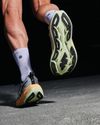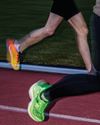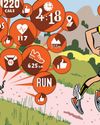
THE RUNNING WORLD has a bias towards effort. We tend to focus on the volume and intensity of our training, and the effect that they have on our cardiovascular fitness. Of course this is important; but it’s not the only piece of the performance puzzle. Gait and technique are also important components of performance, but they’re often overlooked – other than when we buy new running shoes.
While we tend to develop our own running styles, our technique can affect running economy and put a limit on how fast we may eventually be able to run. Poor technique can increase the likelihood of injury, which in turn affects the consistency of your training and thus can hamper your potential to progress. By analysing your technique, you can try to identify some of the key potential risk factors to address with conditioning or drills.
Running technique is dynamic and complex, with lots of moving parts. That complexity can lead to sweeping judgements about ‘good’ or ‘poor’ form, based on how pleasant a runner’s movement is to the eye. The technique and gait you should be interested are those that are effective – in terms of both performance and injury prevention. So don’t try to force your body into a generic, perfect-looking technique. Instead, assess yourself as an individual; think about your injury history, and where you feel stronger or weaker in runs or races, or areas that feel less comfortable than they might.
How to analyse your gait
One approach is to engage the services of a performance lab. Biomechanics labs use sophisticated software to introduce a high level of detail and measurement to your gait analysis. This gives you key data and expert opinion. However, they can be expensive, and obviously, will require you to attend a lab.
Diese Geschichte stammt aus der July/August 2023-Ausgabe von Runner's World SA.
Starten Sie Ihre 7-tägige kostenlose Testversion von Magzter GOLD, um auf Tausende kuratierte Premium-Storys sowie über 8.000 Zeitschriften und Zeitungen zuzugreifen.
Bereits Abonnent ? Anmelden
Diese Geschichte stammt aus der July/August 2023-Ausgabe von Runner's World SA.
Starten Sie Ihre 7-tägige kostenlose Testversion von Magzter GOLD, um auf Tausende kuratierte Premium-Storys sowie über 8.000 Zeitschriften und Zeitungen zuzugreifen.
Bereits Abonnent? Anmelden

LONGOVERDUE PRAISE FOR THE RUNNING SINGLET
In the last decade, the running singlet once reserved for amateur competitors and professional athletes - has gone mainstream, not only on race day but also on everyday runs.

RISE OF THE 'ILLEGAL RUNNING SHOES
Banned shoes emerged at a basketball court long before they found their way onto a marathon course.

CRACKING THE SLEEP CODE
Are you an early bird or a night owl? Perhaps you've assigned yourself another animal after completing an internet quiz. Research is shedding light on the link between well-being and circadian predisposition, but there's no need to rewire yourself. Learn to lean into your biology with our guide.

THE SECRET TO SPEED IS IN YOUP BLOOD
Some of the world's best runners credit this unorthodox Norwegian training method for their success. Is it right for you?

THE MIND OF MASSYN
IN 2024, LOUIS MASSYN WILL ATTEMPT HIS 49TH COMRADES MARATHON AND HE'S LEARNT PLENTY OF LESSONS ALONG THE WAY. HERE'S THE STORY OF HIS AMAZING JOURNEY.

TAKING CHARGE
OUTSPOKEN AND AMBITIOUS, NEW COMRADES RACE MANAGER (AND FORMER WINNER) ANN ASHWORTH IS LOOKING TO TAKE THE RACE INTO THE FUTURE.

A HALF CENTURY OF COMRADES
THIS YEAR, BARRY HOLLAND WILL BE AIMING TO FINISH HIS 50TH CONSECUTIVE COMRADES MARATHON. THIS IS WHAT HAS INSPIRED HIM.

MY RUNNING LIFE
ORDINARY RUNNERS doing EXTRAORDINARY THINGS

Ageing In The Age Of Strava
RECENTLY MY BUDDY Sean sent a text message that said, “Been running a lot of 5:30–6:00 kays early. It feels pretty nice at that pace.”

How To Start A Run When You Don't Feel Like It
I'VE ALWAYS FELT validation when reading a story about writers and their love of procrastination.